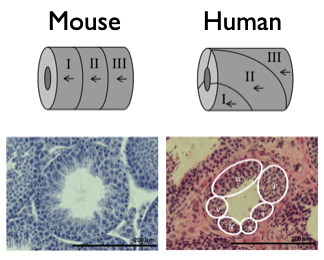研究成果 Research Results
- TOP
- News
- Research Results
- The mathematics of sperm generation
The mathematics of sperm generation
Modeling of spatial patterns in stages of sperm formation provides new tool for investigating reproductive biology 2021.02.25Research ResultsLife & HealthMath & Data
Researchers at Kyushu University have found a mathematical model that can reproduce the spatial pattern of development stages for sperm in vertebrates, providing a new tool for studying the molecular circuitry of sperm formation and understanding the origin of infertility.
Sperm are generated in long thin tubules in the testes. The tubule is subdivided into several stages according to the pattern of sperm differentiation. These stages are spatially aligned sequentially along the seminiferous tubules and repeat periodically, with the pattern of stages moving in one direction over time.

While this pattern is segmental in mice, it forms a spiral in humans, and how these different patterns are generated is still unknown despite this phenomenon being first reported in 1984.
Using mathematical modeling, a research team led by Takashi Miura, professor of Kyushu University’s Faculty of Medical Sciences, has now reproduced this moving wave pattern and found conditions to distinguish segmental and spiral patterns.
The model, which is based on a so-call reaction-diffusion system, allowed the researchers to analyze the pattern dynamics and screen parameters to understand under what condition the segmental or spiral pattern appears.
One new insight the model has already yielded is the theoretical prediction that some segmental patterns exist in human seminiferous tubules, which the researchers were then able to confirm experimentally.

The modeling was part of research done by sixth-year undergraduate student Mari Kawamura of Kyushu University’s School of Medicine with Kei Sugihara and Hisako Takigawa-Imamura, both assistant professors in the Faculty of Medical Sciences, and Toshiyuki Ogawa, professor at Meiji University.
“There is much we can learn about biology using math, and the fusion of these two subjects is still such a new field that many opportunities exist for new researchers and, like in this case, even undergraduate students to immediately make an impact,” says Miura.
The researchers expect that their study will provide a basis for studying the molecular circuitry of this pattern formation and may help to understand the pathogenesis of infertility in the future.
###
For more information about this research, see “Mathematical modeling of dynamic cellular association patterns in seminiferous tubules,” Mari Kawamura, Kei Sugihara, Hisako Takigawa-Imamura, Toshiyuki Ogawa, Takashi Miura, Bulletin of Mathematical Biology (2021). https://doi.org/10.1007/s11538-021-00863-x
This release is also available in Japanese.
Research-related inquiries
Takashi Miura, Professor
Faculty of Medical Sciences
Contact information can also be found in the full release.
- TOP
- News
- Research Results
- The mathematics of sperm generation































